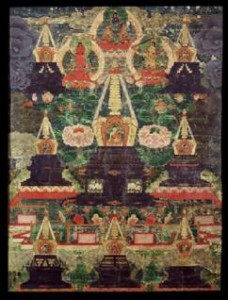Last week, David Rosenberg and I teamed up to lead two Verbal Description and Touch Tours on Pilgrimage and Faith. Armed with an art-cart full of supplies, a bit of humor, and a dose of nerves, we embarked on a new tour strategy that left us both invigorated. In January, we received a series of trainings from Karen Kacen, an avid museum-goer born partially-sighted who instructed our guides and docents on ways to improve accessibility in our museum. These trainings included tips on “Verbal Description,” a technique that conveys the visual world through non-visual language, ways to incorporate touch-objects, and general strategies for guiding and interacting with individuals who have limited vision.
David and I led the participants on a miniature pilgrimage throughout the gallery space, traveling from Bodhgaya to Mecca then to Galicia in the span of an hour. We comparatively discussed certain themes of each traditions’ pilgrimage including the general purpose and intent of the journey, the lives of the Founders, the concept of relics, the collection of souvenirs, etc. The pilgrimage aspect of leaving the comforts of one’s home and enduring hardships on the path was present too (e.g. David’s jokes: “The sculpture in front of you is a wooden statue of St. James that stands about two and a half feet tall; a shade taller than Lyndsey,” a raucous Sir Mix-A-Lot ringtone in the background). But we endured.
Offering tours to individuals who are legally blind or partially sighted presents a list of challenges, but the mutual rewards are aplenty. For example, our pre-tour preparations encouraged us to look deeply at each work of art to ensure we were able to meticulously describe not only the content of the scene, but the composition, color, style, and materials used, allowing participants to paint each image in their head. Having spent so much time in front of this object, even today, I can visualize the painting of the Eight Great Stupas (HAR 73) in my mind’s eye more clearly than any work of art on the floors to date.
David and I began to think deeply about ways we can make these static objects come to life by providing a multi-sensory, three-dimensional experience for the visitors who were relying on us to guide them physically, imaginatively, emotionally, and educationally throughout the gallery experience. This included providing touch-objects such as prayer beads, scallop shells, animal-skin glue sticks, mineral pigments, and incense. We also made sure to provide a safe environment were participants felt comfortable discussing anecdotal stories regarding pilgrimages they had taken as well as fears and misconceptions they had about concepts present in the exhibition.
We began to feel deeply about each participant and the rewards of providing an experience that is unavailable to the partially-sighted in many museums in the city. It was clear that we all left the tour having learned something new about the works of art, the three religions present, and one another. The Touch Tour touched us indeed.
I encourage you to forward additional information on our Verbal Description and Touch Tours to anyone you think this program will benefit, which can be found here.




